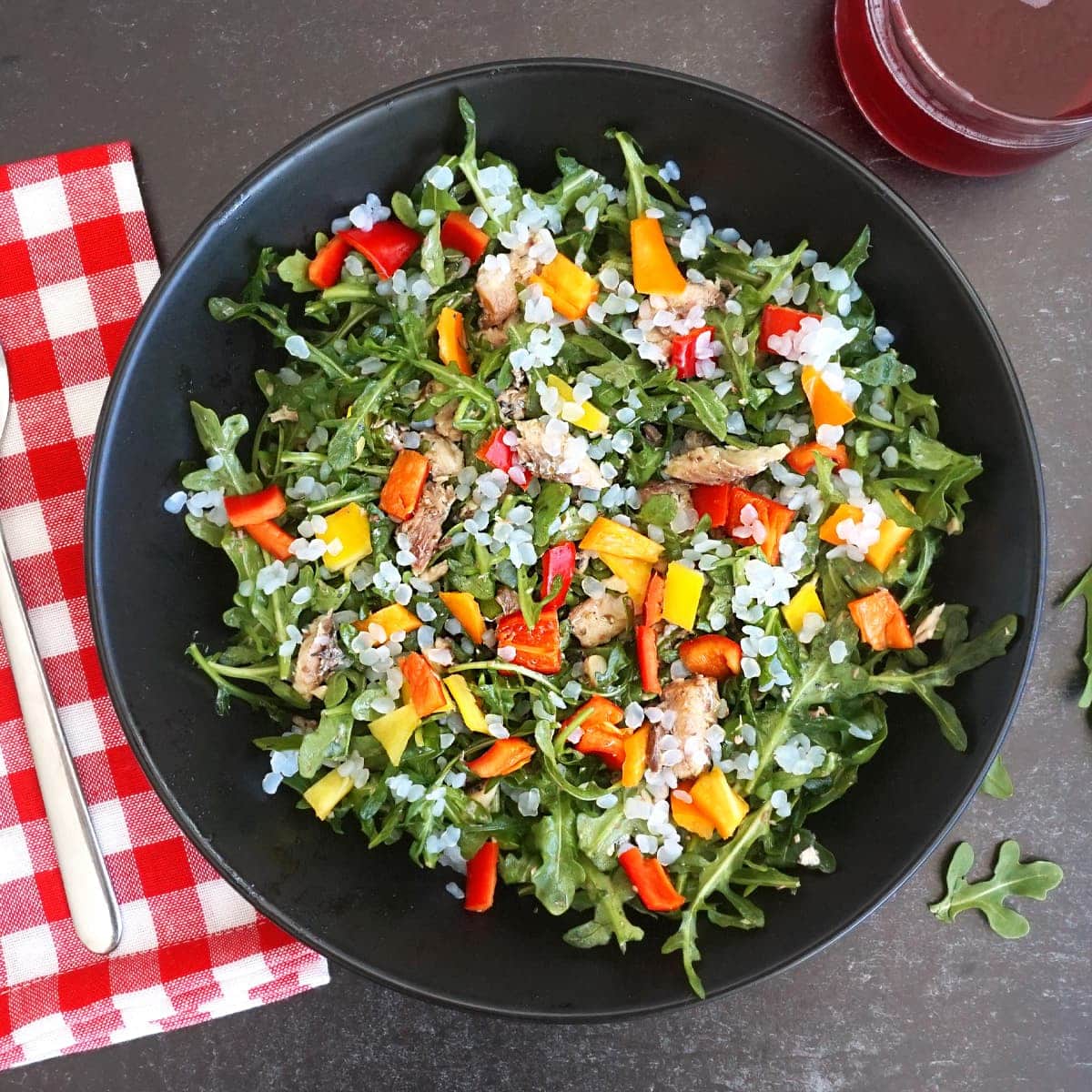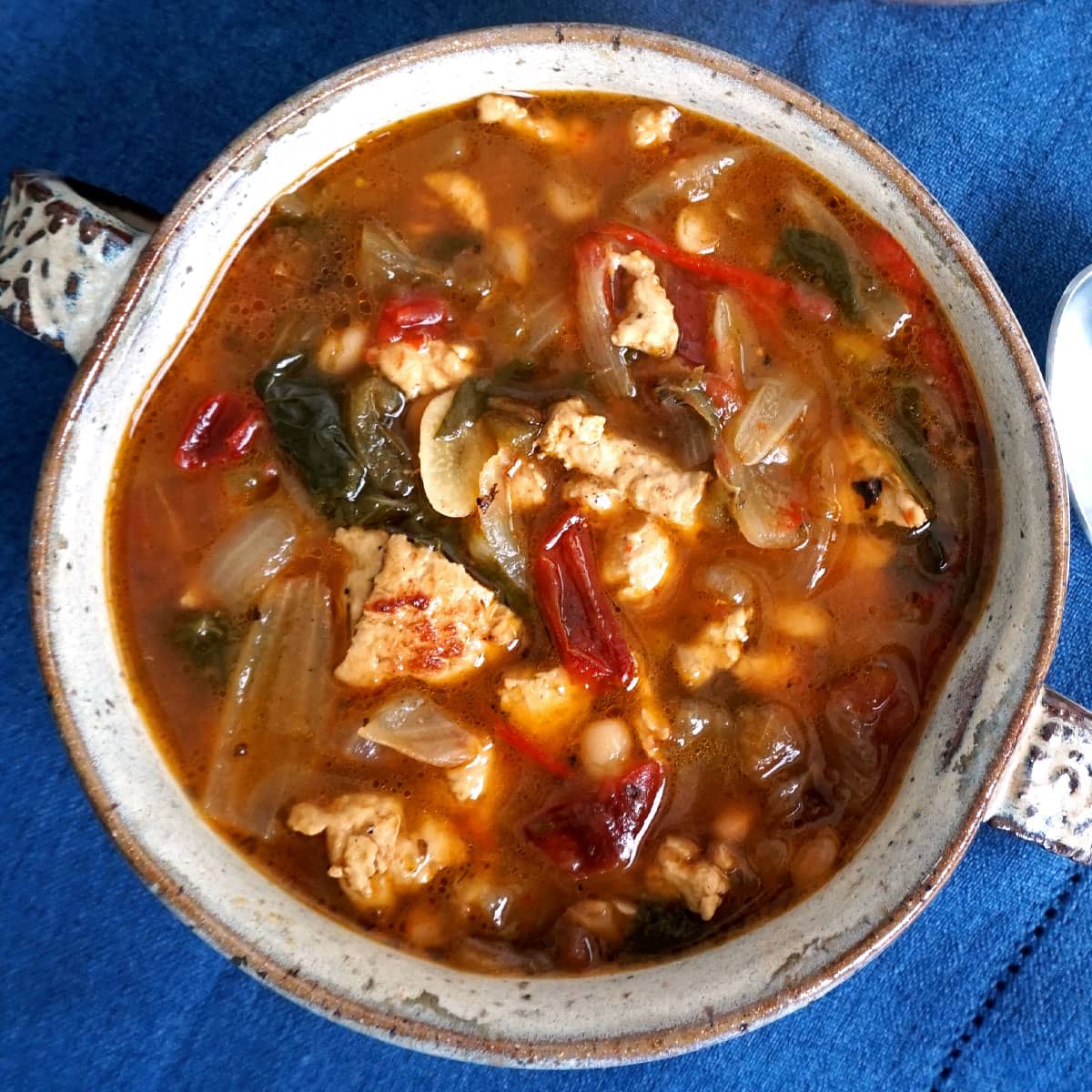
For the holidays, my husband (who is Portuguese) received a care package with typical Portuguese foods, including linguiça. He was a happy camper! One of the ways we used the linguiça was by making this keto-friendly version of caldo verde, which is a Portuguese kale soup. I'm not a big sausage/linguiça fan, but man this soup was delicious! If you're looking for a hearty, creamy and flavorful soup, give this Creamy Keto Caldo Verde a try!
Making Caldo Verde
The first time I made a keto caldo verde I was surprised by how easy it was. There's a lot of flavor in the soup considering how few ingredients there are.
It's not supposed to be creamy
Yes, yes, I know. You caught me. Traditionally speaking, caldo verde is not supposed to be this thick and creamy. It usually includes some potatoes, but the soup is still supposed to be mostly broth. But my husband loves creamy soups so I threw in some extra low-carb veggies (plus, full disclosure, I was experimenting with using alternatives to potatoes and may have over-estimated the amount of cauliflower and zucchini I needed to use). Whatever the reason for making it creamy, we ended up loving this version. I hope you do too!
If you want it to be less creamy and more brothy (the traditional way), you could easily do so by simply adding less vegetables to the soup. Or adding more water. Either way.
Dairy Free
Note that although I say "creamy", there is no actual cream in the soup. Just veggies. The soup is dairy free.

I used linguiça, not chouriço
Seems like I'm breaking all the rules today, because this soup is (traditionally speaking) supposed to use chouriço. But to be fair, linguiça and chouriço are very similar, so either one would work.
So what's the difference anyways? Let's clear that up.
Chouriço vs. Linguiça
Chouriço is the most common sausage, and is similar to the Spanish chorizo. A thick sausage made with pork and spices, most notably paprika, it is smoked, cured and packed with flavor. Although, as with any sausage, the final flavor profile will depend on who makes it.
Linguiça is similar to chouriço, but is typically skinnier (more similar to a hot dog in terms of thickness) and it typically heavier on the spices, especially garlic. I use the word "typically" because it all depends on where you get it from and who made it.
Kale or Collard Greens?
Ok, you caught me again. I used the wrong greens. That's three strikes I guess.
Even though it's typically translated to "Portuguese Kale Soup" and often made with kale, caldo verde is traditionally made with collard greens. However, collard greens can be tricky. If you don't prepare them properly, it can give the soup a bitter taste. If you want to prepare this soup the traditional way, just swap out the kale for collard greens. However, make sure you don't let them cook for too long, as overcooking them will enhance the bitter flavor. You might also consider blanching the collard greens in a separate pot of water before adding them to the soup before serving.
For my recipe I used lacinato kale, which is also known as Tuscan kale or Italian kale. The leaves are softer than most of the other kinds of kale, so it takes less time to cook. I used this specific type because I thought it would do best in the soup, since the kale is only added at the very end. However, you could certainly use any type of leafy greens you wish, kale or otherwise.

Nutrition
The type of sausage you use will greatly impact the fat and protein content (and carbs if it has hidden carbs in it), so use the nutritional information below as an estimate only. Be sure that when you are choosing a sausage, that it does not have any fillers or hidden carbs in it. A high quality sausage should not have fillers, just meat and spices (and preservatives since they're usually cured).
Net Carbs
This soup is a bit high on the net carbs for my liking. That being said, I went heavy on the veggies on purpose in order to thicken it up... so I guess that's my own fault.
If you wanted to reduce the net carbs, just use half the veggies. By using half an onion, half the cauliflower and only one zucchini, you'd reduce the net carbs from 7.4g down to 5.3g per serving. That's probably more similar to the traditional version of this soup anyways.
Tips & Tricks
- If the soup gets too thick, just add more water.
- Traditionally this soup is not so thick and creamy. If you prefer it this way, use half the amount of veggies. By using half an onion, half the cauliflower and only one zucchini, it will not only be thinner, but will also decrease the net carbs down to 5.3g per serving.
- The type of sausage you use will make a big difference in the final outcome. Here in the US, we got our linguiça delivered from Chaves Market in Massachusetts. If you're in New Jersey, Rhode Island, Massachusetts or Florida, you could also go to Seabra supermarket. There are many other local markets that sell chouriço, so just use Google to see what's in your area. When all else fails, most grocery stores sell the similar Spanish-style chorizo, which could be used if needed.
- Traditionally, caldo verde is served with one slice of sausage on top, but you could certainly add more if you want to.
- It's nearly impossible for me to tell you how much salt/pepper to add, because it depends on the sausage you are using. If you use a sausage that is very salty and/or spicy, then you might not need to add additional salt and pepper at all. Make sure you taste the soup before serving and add salt and/or pepper as needed.
Check out more Portuguese dishes.
Check out more Soup recipes.
📖 Recipe

Creamy Keto Caldo Verde (Portuguese Kale Soup)
Equipment
Ingredients
- 8 oz linguiça or chouriço
- ¼ cup olive oil
- 1 onion, sliced
- 2 cloves of garlic, sliced
- 20 oz cauliflower
- 2 medium zucchini
- 10 cups water
- 1 bunch lacinato kale, thinly sliced (approximately 15 leaves)
- salt and pepper (see note)
Instructions
- Slice the linguiça crosswise, with each piece about ¼-inch (½-cm) thick. Add the olive oil and linguiça slices to a large pot and sauté the sausage for 10 minutes, flipping them over half way through. Remove the linguiça, but leave the juices in the pot.
- Add the onion and garlic to the pot of juices and sauté for 8-10 minutes, or until soft. Add the cauliflower, zucchini and water. Cover and simmer for 30 minutes. Once the cauliflower and zucchini are soft enough to be cut/smashed by a spoon, remove from the heat and blend the soup with an immersion blender. Be careful not to let it spash... the soup is hot!
- Add the kale to the soup, return to the heat and let simmer for an additional 10 minutes. Cut the slices of linguiça in half (or if using a larger chouriço, cut in quarters) and add them back into the soup, saving a few slices for the top of each bowl. Traditionally, caldo verde is served with one slice of linguiça on top of each bowl.
Notes
Nutrition
Nutrition information is estimated. Amounts may vary depending on the specific brand and/or type of ingredients you use. Sugar alcohols and other sweeteners that typically do not effect blood glucose levels, including but not limited to erythritol and allulose, are excluded from the carb count.






Comments
No Comments